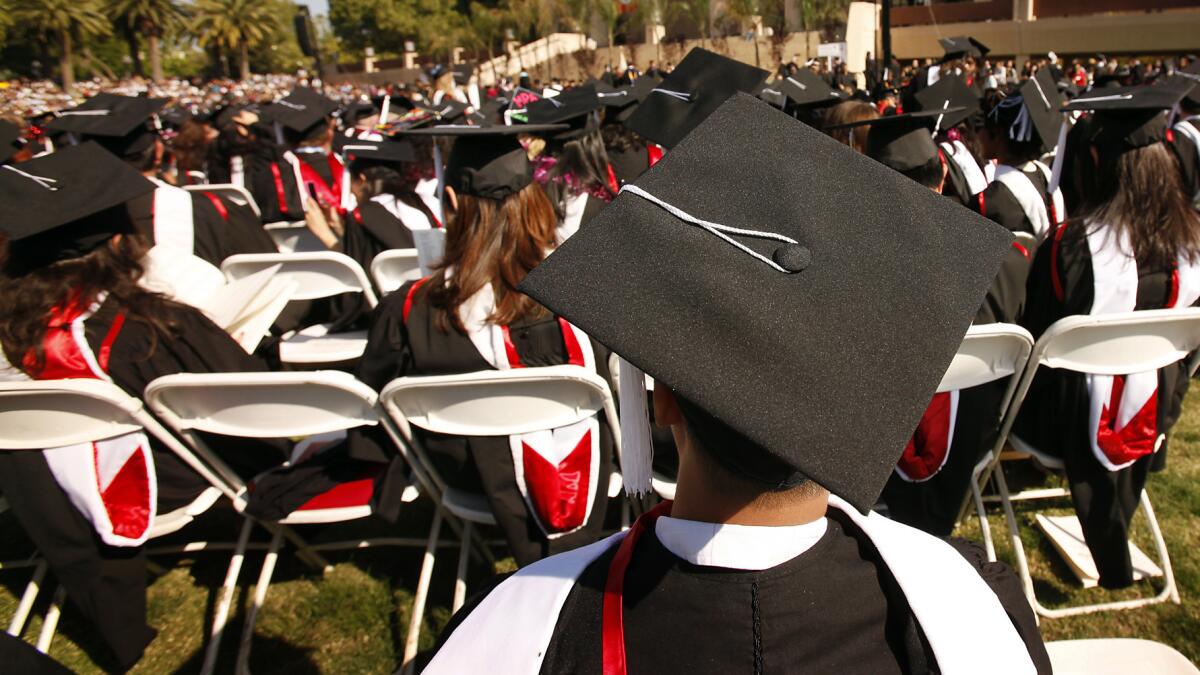Two women named to lead Cal State campuses as graduation rates rise

Commencement ceremonies at Cal State Northridge.
California State University trustees Wednesday appointed two women to lead the campuses in San Jose and Sonoma and got some good news about efforts to reduce the time it takes for students to earn a degree.
San Jose State University, one of the largest campuses in the system, will be headed by Mary A. Papazian, a veteran East Coast educator, trustees announced Wednesday.
Judy K. Sakaki, a California native now vice president of student affairs in the office of University of California President Janet Napolitano, will become president of Sonoma State University.
At UC, Sakaki, 62, has overseen policies and services for 238,000 students at 10 campuses as a member of Napolitano’s cabinet. She has also led fundraising efforts for scholarships and other student programs.
She previously served as vice president for student affairs at UC Davis and as a vice president at Fresno State University.
Sakaki earned a bachelor’s degree in human development and a master’s degree in educational psychology from Cal State Hayward, now Cal State East Bay. She also has a doctorate in education from UC Berkeley.
Sakaki’s experience with California education systems and her work with students stood out, said Cal State trustee Lupe Garcia, chairwoman of the search committee.
”Her extensive and stellar work in student affairs complements the university’s mission of improving student retention and graduation rates,” Garcia said in a statement.
Sakaki’s salary was set at $298,000, $7,000 less than her predecessor and based on her experience and length of service, Chancellor Timothy P. White said. She will also receive a $60,000 housing allowance and a $1,000 monthly auto allowance.
Papazian, 56, currently serves as president of Southern Connecticut State University in New Haven, which serves 11,000 students. In her new role as president of San Jose State, she will be responsible for nearly 33,000 students.
She will take over for interim president Susan Martin, who was appointed in August following the departure of President Mohammad Qayoumi. Qayoumi left after four years to take an advisory position with the Afghanistan government.
“I look forward to working alongside the many dedicated faculty and staff who guide students along their academic journey and prepare them for achievements beyond the classroom,” Papazian said in a statement.
In Connecticut, Papazian oversaw the creation of several undergraduate and graduate programs as well as an expansion of academic buildings and other facilities. She previously served as provost and senior vice president for academic affairs at Lehman College of The City University of New York, as dean of the College of Humanities and Social Sciences at Montclair State University in New Jersey and as associate dean of the College of Arts and Sciences at Oakland University in Rochester, Mich.
Papazian is a Southern California native and holds bachelor’s, master’s and doctoral degrees from UCLA.
”She has extensive academic leadership experience and a knack for connecting campus, organizational and political leaders to higher education,” trustee Rebecca Eisen, said in a statement.
Papazian will receive a salary of $371,000, $72 less than her predecessor, and will be required to live in the university-owned president’s residence. She will also receive a monthly $1,000 auto allowance.
The appointments of Sakaki and Papazian come a day after White called for more diversity in hiring and in the development of curriculum throughout the 23-campus system. With the new appointments, 15 of the campuses will be led by women or minorities.
On the second day of their meeting in Long Beach, the trustees learned that the Cal State system exceeded its goal of raising six-year graduate rates.
The universities set out to raise the six-year graduation rate for freshmen who enrolled in 2009 from 46% to 54%. In reality, about 57% of freshmen who entered Cal State in 2009 earned their degree within six years.
Over the last decade, less progress was made in closing achievement gaps between ethnic, racial and socioeconomic groups.
From 2005 to 2015, the six-year graduation rate increased from 27% to 42% for African American students, from 40% to 52% for Latinos students, from 47% to 61% for Asian American students and from 52% to 64% for white students.
Nearly 52% of students who qualified for low-income federal Pell grants graduated in 6 years, while 60% of non-Pell students graduated in that time. The disparity in four-year graduation rates was starker; about 11% of Pell students graduated in that time versus 22% of non-Pell students.
Gov. Jerry Brown has criticized the university system for failing to graduate more students within four years. His recent budget proposal included unflattering comparisons with other public universities around the country that are doing far better.
The national four-year average for public universities is about 34%. The system-wide four-year average at Cal State is about 17%. White wants to raise that rate to 24% by 2025.
“Looking at those numbers in the governor’s budget report, you want to say, ‘Ouch, they are painful numbers to see,’ ” trustee Peter Taylor said.
White said that the median time to earn a degree was 4.7 years at Cal State and 4.3 years at the University of California.
Cal State officials argue that 4-year graduation rates don’t accurately measure how students are performing because many work while attending school and are unprepared for college-level English and math.
“The whole issue here can paint a misleading picture of underperformance,” White said. But he added: “I will never apologize for the complexity of our students.”
Follow me on Twitter @CarlaRiveralat.
ALSO
Cal State chancellor tackles tuition, diversity and salaries
Graduation rates are on the agenda as Cal State trustees meet in Long Beach
From L.A. Unified teacher to superintendent: Who is the real Michelle King?
More to Read
Sign up for Essential California
The most important California stories and recommendations in your inbox every morning.
You may occasionally receive promotional content from the Los Angeles Times.











